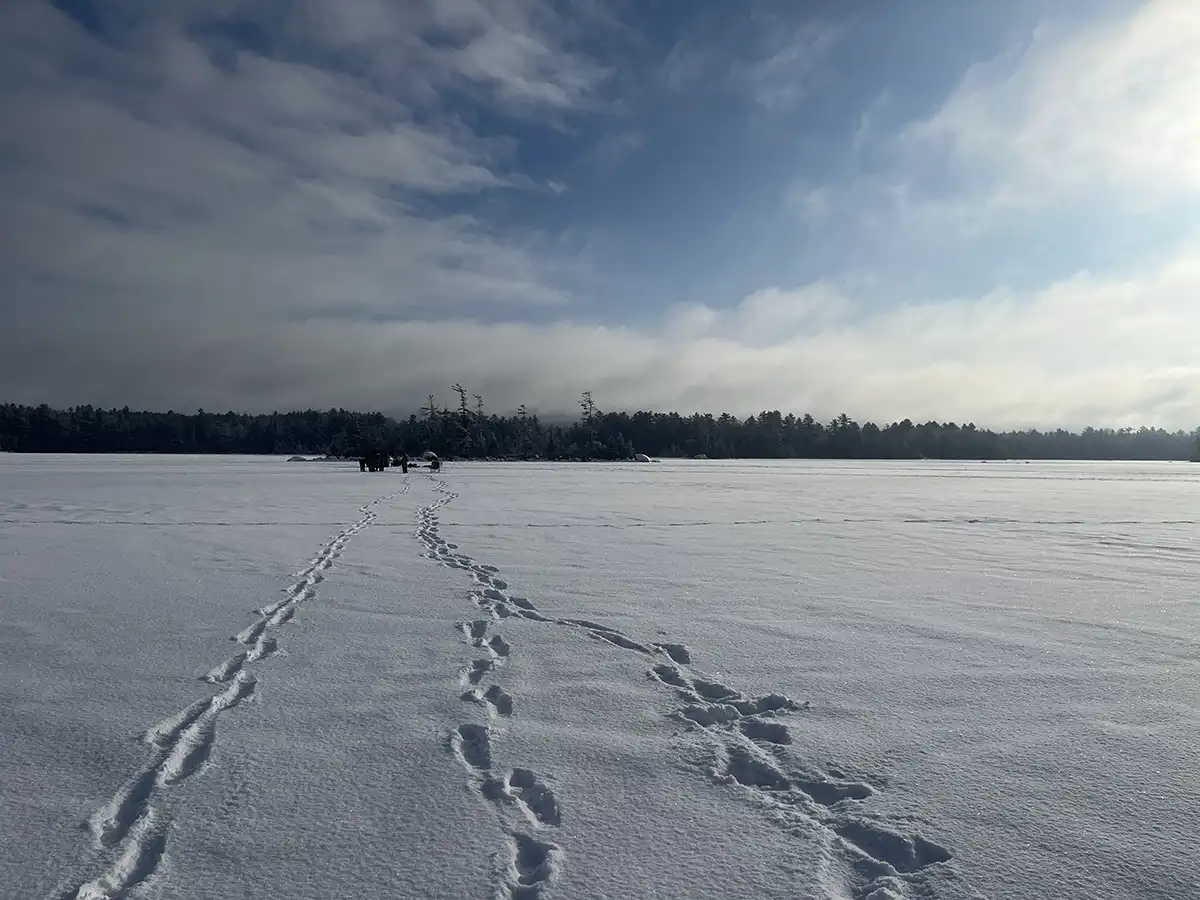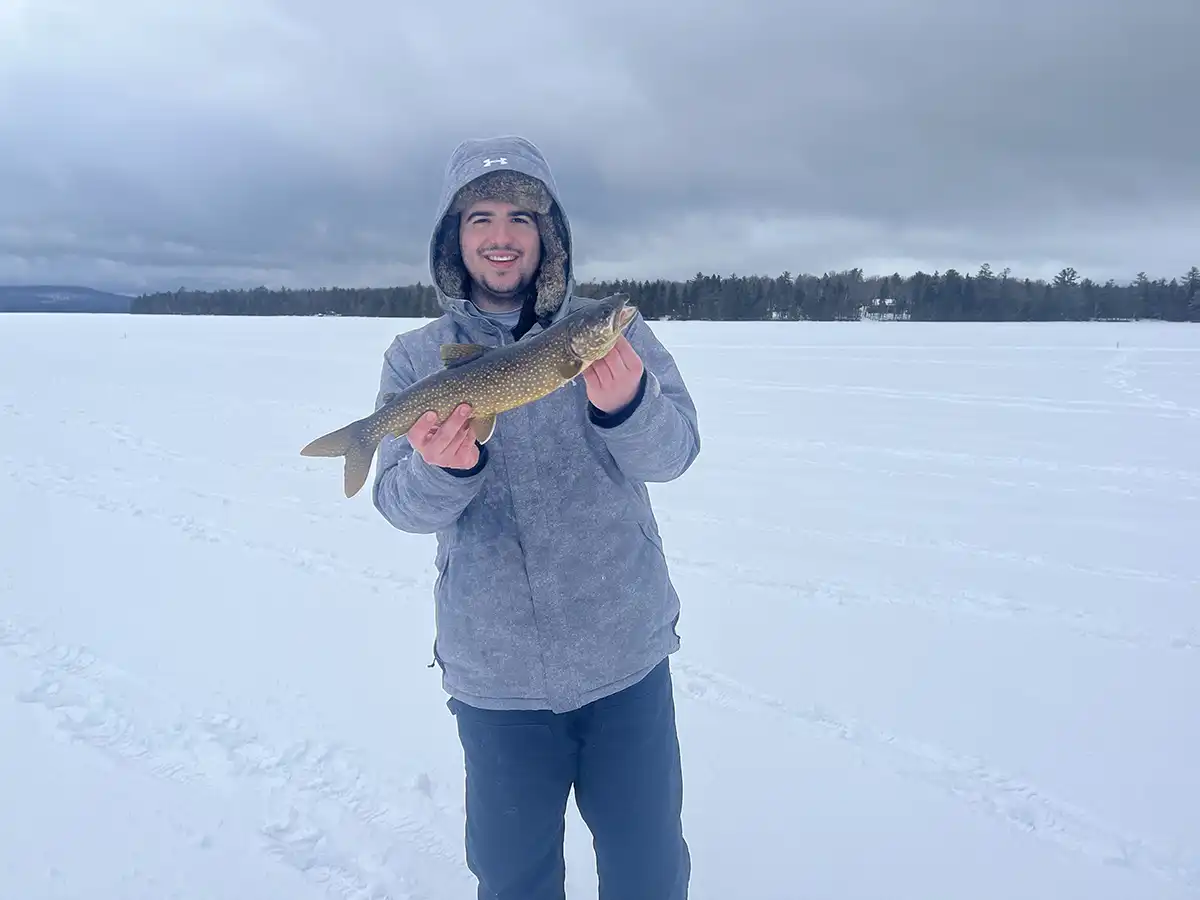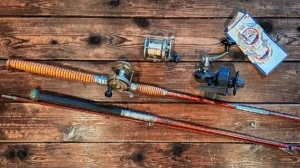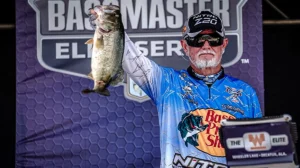As a young ice angler, I was a dedicated tip-up fisherman. Upon arrival at the lake, I would position my limit of set lines baited with the largest shiners I could find. After set-up was complete, I would station myself in a lawn chair and not so patiently wait for flags to fly. That all changed when one Christmas, a Vexilar unit made its way under the tree. From that day forward I followed the principles of the great Dave Genz to a tee, turning lakes and ponds into Swiss cheese and covering as much water as possible.
My ice-fishing approach took its final form when a savvy local angler and eventual fishing mentor took me under his wing. He taught me that I could do both, experience the adrenaline shot that only a flag could provide, and pick off active fish by utilizing electronics. While ice fishing still holds a near and dear place in my heart, I now live in South Carolina and only get one week a year on the ice during my family’s annual trip.
This year, we hit the road and headed to Maine to chase lake trout, locally known as togue, a fish that responds well to both tactics. While the Pine Tree State certainly does not have the giant lake trout of the Canadian Shield or Great Lakes, it does have lakes with tremendous populations and some of the prettiest scenery an angler could hope to fish in. With less-than-ideal ice conditions, sporadic weather, and newbie ice anglers, we leaned heavily on the use of tip-ups to make the trip a success.

WHAT IS A TIP-UP?
For those who are not familiar, a tip-up is a set-line device that is positioned over a hole in the ice. Below the water, a reel extends down. When a fish takes the bait, the reel moves, triggering a brightly colored flag to spring up, alerting the angler of a bite. Tip-up varieties greatly vary by region. In the Northeast, we commonly utilize styles that feature a cross member holding the device above the hole. In the Midwest, plank-style tip ups, such as the Beaver Dam Original Rail Tip-Up are popular. Other style options include the Frabill Pro-Thermal Tip-Up, which insulates the hole and keeps it free of snow and slush.
It is important to choose a tip-up style that works best for the situation you find yourself in. For example, on the large lakes of Northern Maine, it is important to set expansive spreads to completely cover complex reef systems and other offshore features. For that application, the Heritage Tackle Laker Classic Tip-Up is an optimal choice. The flag flies high and can be seen for long distances and the spool is large enough to handle the trademark heavy runs of the lake trout.
TIP-UP LOCATIONS FOR LAKE TROUT
In the wintertime, lake trout are on the search for schools of baitfish. With Maine fisheries being mostly smelt-supported, fish can be found just about anywhere. Through the ice, I have caught lake trout in as little as two feet of water within steps of the shoreline, out to over one hundred feet in main lake basins. However, humps, drop offs, and extended points are all very productive areas to begin searching for active fish.
Once an attractive piece of structure is selected, begin the day by blanketing the entire area with a grid of tip-ups. A helpful tip is to be sure to cover both the shallowest areas along with the deepest sections. Examples of this include the top and bottom ends of points, along with the high and low sides of a drop off.
This same principle applies to the water column. Never be afraid to set tip-ups right under the ice along with some baits directly on or just off the bottom. If you have access to a sonar unit, pay attention to where you are marking bait in the water column. Odds are, lake trout are going to be found in the same area.
SETTING A TIP-UP
No matter what style tip-up you use, the same steps are used when setting up. First and most importantly, you need to clean the hole of all the slush. Then, you need to set the bait to the appropriate depth. This can be done one of two ways, the first being to use a sonar unit to pick up your bait on the way down. While this is very efficient and keeps exposed fingers to a minimum, I prefer the old-school method of using a sounder or depth finder which is simply a chunk of lead with an alligator clip that attaches to the hook. My long-standing favorite model is the Northland Hot-Spot Depth Finder.
To avoid needing to find the depth every time the bait is pulled up, I use a standard button that can slide up and down the line. A pro tip: don’t pluck these off the dress shirts your mother purchased for you, instead bulk buttons can be found at any arts and craft store. Other options are tip-up line markers which do not need to be maneuvered up and down the line.
Begin by clipping the sounder to your hook and pulling the button up the line until the sounder hits the bottom. From there, simply slide the button back down the line to your desired depth. After that, the sounder is pulled back up through the hole, and the bait is hooked and sent back down until the button is back on the spool. When letting the bait down, do so slowly to avoid tangles. This can often take some time with larger baits. Always be prepared to have a fish eat the bait on the way down.
BAIT OPTIONS
When it comes to lake trout, bait options are pretty straightforward. Lively specimens of the main forage present are going to be your best bet. In the Northeast, smelt are most common, in other parts of the country, emerald shiners play a large role. Live suckers or golden pond shiners can also be good options when chasing large fish.
To make sure bait is kept as fresh as possible, be sure to utilize aeration systems such as the Bass Pro Shops Aerator to keep water highly oxygenated. Another note on bait care is to make sure bait buckets are kept ice free. The rapidly freezing water traps a lot of oxygen and can do a lot of harm to bait.
TIP-UP RIGGING FOR LAKE TROUT
Tip-ups need to be spooled with a heavy-duty nylon main line in a line class that can handle any species you plan on encountering during the season. Nylon features relatively zero stretch properties and sheds water which is important in limiting frozen piles of line on the ice. A great option is the Woodstock Tip-Up Line which can be purchased in bulk. While standard braid can be used, its small diameter makes it hard to hold onto and has been known to shred fingers and palms.
From there, a barrel swivel is attached and standard live bait rigging is used. For lake trout, I favor ten to fifteen-pound Berkley Vanish Leader Material down to a Gamakatsu Octopus Hook. Hook size greatly depends on the bait being utilized. Sometimes a split shot is needed to assist in getting larger baits down to depth. I prefer to only use one if necessary as they can limit the amount the live bait is free to swim.
There are a few easy ways to elevate your presentation. One is by adding a Colorado Spinner Blade up the leader for added attraction. This is done by using a Quick Change Snap Clevis anchored by a micro split shot or bobber stop on either side to keep it in place. For lake trout, holographic patterns or orange and hammered copper are always hot blade options.
When using larger baits such as suckers or pond shiners, one hook is often unreliable to secure quality hookups. To remedy this, my friend Alex concocted the turbo rig, a variation of the fabled quick-strike rig that features an octopus hook followed by a small treble hook. In addition to hook set advantages, the rig also does a great job of keeping the bait secured throughout the entire fight. With live bait prices on the rise, keeping these large specimens to use as dead bait or nighttime burbot bait is always a good idea.
TIP-UP PROTOCOL
As you look up from a steaming bowl of venison chili, your heart skips a beat as you notice a high-flying flag dancing in the breeze, now what? The first step is to make sure it is a legitimate flag, in windy conditions, it is common for a heavy gust to blow the flag off the tripping mechanism. These instances are the ultimate letdown and can be avoided by paying attention to wind direction when situating tip-ups. Another tip is to not be in a huge rush to the flag, noise travels fast under the ice and nothing makes a fish drop the bait faster than a stampede of excited anglers stomping over top of them. There is also normally one angler in every crew who insists on bringing ice skates along. If the ice is free of snow, make sure that individual stays far away from the spread for this very reason.
Once you rule out a “wind flag,” it is time to check in on the status of the fish. The most obvious sign of a live line is if the spool is actively spinning. Other good signs are if the line is far off to the side of the hole. The next step is to take out a good segment of line directly from the spool and pile it neatly on the ice, this acts as an emergency stockpile in case the fish takes an unexpected run while getting the tip-up away from the hole. From a young age, my fishing mentors drilled it into my head to never set the hook on a tip-up fish if it is not actively moving away from the angler. I have learned the hard way on multiple occasions that if this rule is not practiced, you risk pulling the hook right out of the fish’s mouth.
The last and most exciting part of the process is feeling the fish pull the line through your fingers, now it is time to set the hook by giving a smooth yank. From here, the angler must pull the fish in hand over hand. Special care should be taken to drop all gained line onto the ice to avoid creating a big tangled mess. Since there is no reel involved, the drag is your fingers. If the fish wants to make a run, loosen your grip on the line and let it take as much as it wants; all the more reason to make sure the line does not become knotted.
Tensions often reach a fever pitch when the fish nears the hole as this is when catastrophe can strike. The line can begin cutting into the bottom edge of the hole. Swivels, weights, and even hook eyes can get stuck giving big fish the leverage they need to shake free. Fish do not like being turned up through the hole, give them as much time as they need until you can coerce them topside.
SHAKING THE TIPS
To maximize outings, be sure to periodically check all set lines. On cold days, ice builds up fast and needs to be chipped clean. There is nothing worse than seeing the spool humming and not being able to get to it due to heavy ice formation. On windy days, snow can blow into the hole which can cause a tip-up not to trigger and turn gear into a block of ice. Also, this is a great time to pull up the bait and inspect for liveliness. Sometimes a fish can stun a bait without moving the spool resulting in a mangled presentation.
While this certainly creates a lot of work, it is common to have a flurry of flags pop after a round of maintenance. My theory is that fish are inspecting the bait and the extra movement caused by cleaning the hole triggers a strike.
With the rise of technology, tip-ups can often be cast aside in favor of the latest and greatest in ice fishing sonar technology and exciting jigging tactics. Whether your goal is to create fast action for fresh ice anglers or pick up a few extra fish, tip-ups can’t be beat!
















